Chen Jiang
Minimal Semantic Sufficiency Meets Unsupervised Domain Generalization
Sep 19, 2025Abstract:The generalization ability of deep learning has been extensively studied in supervised settings, yet it remains less explored in unsupervised scenarios. Recently, the Unsupervised Domain Generalization (UDG) task has been proposed to enhance the generalization of models trained with prevalent unsupervised learning techniques, such as Self-Supervised Learning (SSL). UDG confronts the challenge of distinguishing semantics from variations without category labels. Although some recent methods have employed domain labels to tackle this issue, such domain labels are often unavailable in real-world contexts. In this paper, we address these limitations by formalizing UDG as the task of learning a Minimal Sufficient Semantic Representation: a representation that (i) preserves all semantic information shared across augmented views (sufficiency), and (ii) maximally removes information irrelevant to semantics (minimality). We theoretically ground these objectives from the perspective of information theory, demonstrating that optimizing representations to achieve sufficiency and minimality directly reduces out-of-distribution risk. Practically, we implement this optimization through Minimal-Sufficient UDG (MS-UDG), a learnable model by integrating (a) an InfoNCE-based objective to achieve sufficiency; (b) two complementary components to promote minimality: a novel semantic-variation disentanglement loss and a reconstruction-based mechanism for capturing adequate variation. Empirically, MS-UDG sets a new state-of-the-art on popular unsupervised domain-generalization benchmarks, consistently outperforming existing SSL and UDG methods, without category or domain labels during representation learning.
Exploiting Layer Normalization Fine-tuning in Visual Transformer Foundation Models for Classification
Aug 11, 2025Abstract:LayerNorm is pivotal in Vision Transformers (ViTs), yet its fine-tuning dynamics under data scarcity and domain shifts remain underexplored. This paper shows that shifts in LayerNorm parameters after fine-tuning (LayerNorm shifts) are indicative of the transitions between source and target domains; its efficacy is contingent upon the degree to which the target training samples accurately represent the target domain, as quantified by our proposed Fine-tuning Shift Ratio ($FSR$). Building on this, we propose a simple yet effective rescaling mechanism using a scalar $\lambda$ that is negatively correlated to $FSR$ to align learned LayerNorm shifts with those ideal shifts achieved under fully representative data, combined with a cyclic framework that further enhances the LayerNorm fine-tuning. Extensive experiments across natural and pathological images, in both in-distribution (ID) and out-of-distribution (OOD) settings, and various target training sample regimes validate our framework. Notably, OOD tasks tend to yield lower $FSR$ and higher $\lambda$ in comparison to ID cases, especially with scarce data, indicating under-represented target training samples. Moreover, ViTFs fine-tuned on pathological data behave more like ID settings, favoring conservative LayerNorm updates. Our findings illuminate the underexplored dynamics of LayerNorm in transfer learning and provide practical strategies for LayerNorm fine-tuning.
Structure-aware Semantic Discrepancy and Consistency for 3D Medical Image Self-supervised Learning
Jul 03, 2025Abstract:3D medical image self-supervised learning (mSSL) holds great promise for medical analysis. Effectively supporting broader applications requires considering anatomical structure variations in location, scale, and morphology, which are crucial for capturing meaningful distinctions. However, previous mSSL methods partition images with fixed-size patches, often ignoring the structure variations. In this work, we introduce a novel perspective on 3D medical images with the goal of learning structure-aware representations. We assume that patches within the same structure share the same semantics (semantic consistency) while those from different structures exhibit distinct semantics (semantic discrepancy). Based on this assumption, we propose an mSSL framework named $S^2DC$, achieving Structure-aware Semantic Discrepancy and Consistency in two steps. First, $S^2DC$ enforces distinct representations for different patches to increase semantic discrepancy by leveraging an optimal transport strategy. Second, $S^2DC$ advances semantic consistency at the structural level based on neighborhood similarity distribution. By bridging patch-level and structure-level representations, $S^2DC$ achieves structure-aware representations. Thoroughly evaluated across 10 datasets, 4 tasks, and 3 modalities, our proposed method consistently outperforms the state-of-the-art methods in mSSL.
SD-MAD: Sign-Driven Few-shot Multi-Anomaly Detection in Medical Images
May 22, 2025Abstract:Medical anomaly detection (AD) is crucial for early clinical intervention, yet it faces challenges due to limited access to high-quality medical imaging data, caused by privacy concerns and data silos. Few-shot learning has emerged as a promising approach to alleviate these limitations by leveraging the large-scale prior knowledge embedded in vision-language models (VLMs). Recent advancements in few-shot medical AD have treated normal and abnormal cases as a one-class classification problem, often overlooking the distinction among multiple anomaly categories. Thus, in this paper, we propose a framework tailored for few-shot medical anomaly detection in the scenario where the identification of multiple anomaly categories is required. To capture the detailed radiological signs of medical anomaly categories, our framework incorporates diverse textual descriptions for each category generated by a Large-Language model, under the assumption that different anomalies in medical images may share common radiological signs in each category. Specifically, we introduce SD-MAD, a two-stage Sign-Driven few-shot Multi-Anomaly Detection framework: (i) Radiological signs are aligned with anomaly categories by amplifying inter-anomaly discrepancy; (ii) Aligned signs are selected further to mitigate the effect of the under-fitting and uncertain-sample issue caused by limited medical data, employing an automatic sign selection strategy at inference. Moreover, we propose three protocols to comprehensively quantify the performance of multi-anomaly detection. Extensive experiments illustrate the effectiveness of our method.
ChromFound: Towards A Universal Foundation Model for Single-Cell Chromatin Accessibility Data
May 19, 2025Abstract:The advent of single-cell Assay for Transposase-Accessible Chromatin using sequencing (scATAC-seq) offers an innovative perspective for deciphering regulatory mechanisms by assembling a vast repository of single-cell chromatin accessibility data. While foundation models have achieved significant success in single-cell transcriptomics, there is currently no foundation model for scATAC-seq that supports zero-shot high-quality cell identification and comprehensive multi-omics analysis simultaneously. Key challenges lie in the high dimensionality and sparsity of scATAC-seq data, as well as the lack of a standardized schema for representing open chromatin regions (OCRs). Here, we present \textbf{ChromFound}, a foundation model tailored for scATAC-seq. ChromFound utilizes a hybrid architecture and genome-aware tokenization to effectively capture genome-wide long contexts and regulatory signals from dynamic chromatin landscapes. Pretrained on 1.97 million cells from 30 tissues and 6 disease conditions, ChromFound demonstrates broad applicability across 6 diverse tasks. Notably, it achieves robust zero-shot performance in generating universal cell representations and exhibits excellent transferability in cell type annotation and cross-omics prediction. By uncovering enhancer-gene links undetected by existing computational methods, ChromFound offers a promising framework for understanding disease risk variants in the noncoding genome.
SegAnyPET: Universal Promptable Segmentation from Positron Emission Tomography Images
Feb 20, 2025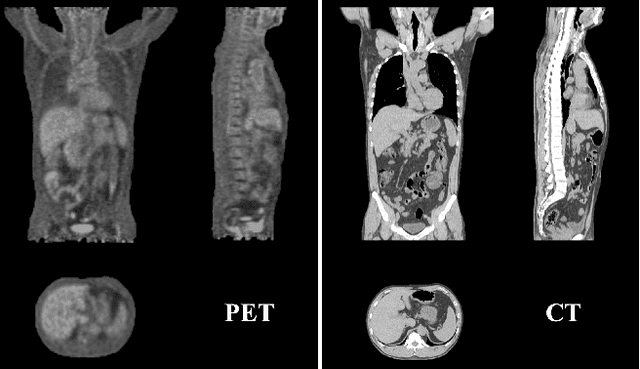
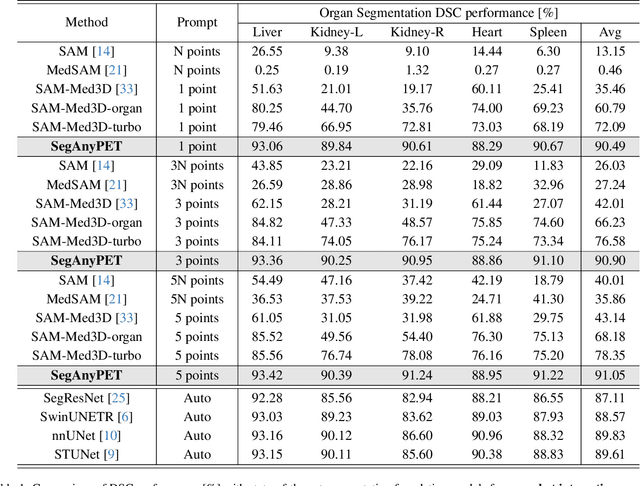
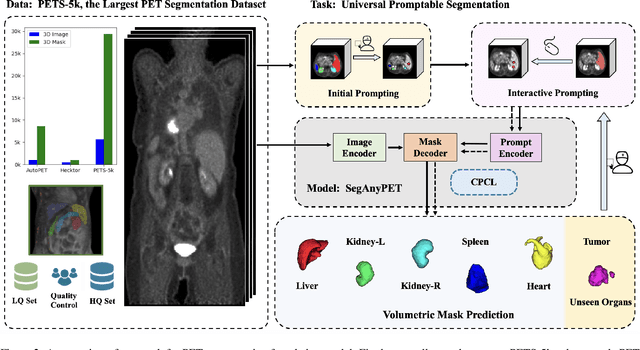
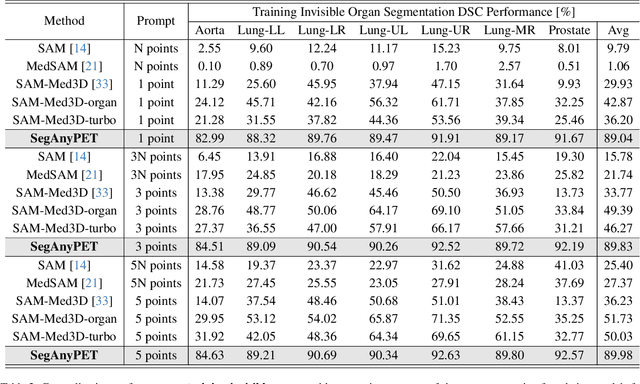
Abstract:Positron Emission Tomography (PET) imaging plays a crucial role in modern medical diagnostics by revealing the metabolic processes within a patient's body, which is essential for quantification of therapy response and monitoring treatment progress. However, the segmentation of PET images presents unique challenges due to their lower contrast and less distinct boundaries compared to other structural medical modalities. Recent developments in segmentation foundation models have shown superior versatility across diverse natural image segmentation tasks. Despite the efforts of medical adaptations, these works primarily focus on structural medical images with detailed physiological structural information and exhibit poor generalization ability when adapted to molecular PET imaging. In this paper, we collect and construct PETS-5k, the largest PET segmentation dataset to date, comprising 5,731 three-dimensional whole-body PET images and encompassing over 1.3M 2D images. Based on the established dataset, we develop SegAnyPET, a modality-specific 3D foundation model for universal promptable segmentation from PET images. To issue the challenge of discrepant annotation quality of PET images, we adopt a cross prompting confident learning (CPCL) strategy with an uncertainty-guided self-rectification process to robustly learn segmentation from high-quality labeled data and low-quality noisy labeled data. Experimental results demonstrate that SegAnyPET can correctly segment seen and unseen targets using only one or a few prompt points, outperforming state-of-the-art foundation models and task-specific fully supervised models with higher accuracy and strong generalization ability for universal segmentation. As the first foundation model for PET images, we believe that SegAnyPET will advance the applications to various downstream tasks for molecular imaging.
Aneumo: A Large-Scale Comprehensive Synthetic Dataset of Aneurysm Hemodynamics
Jan 17, 2025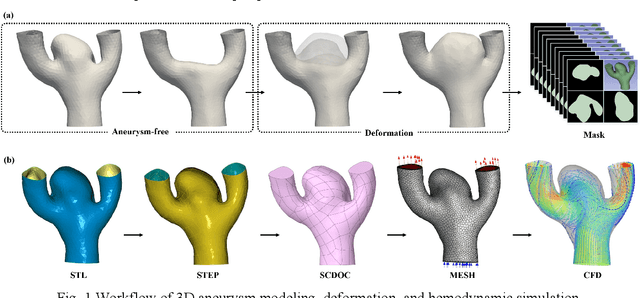
Abstract:Intracranial aneurysm (IA) is a common cerebrovascular disease that is usually asymptomatic but may cause severe subarachnoid hemorrhage (SAH) if ruptured. Although clinical practice is usually based on individual factors and morphological features of the aneurysm, its pathophysiology and hemodynamic mechanisms remain controversial. To address the limitations of current research, this study constructed a comprehensive hemodynamic dataset of intracranial aneurysms. The dataset is based on 466 real aneurysm models, and 10,000 synthetic models were generated by resection and deformation operations, including 466 aneurysm-free models and 9,534 deformed aneurysm models. The dataset also provides medical image-like segmentation mask files to support insightful analysis. In addition, the dataset contains hemodynamic data measured at eight steady-state flow rates (0.001 to 0.004 kg/s), including critical parameters such as flow velocity, pressure, and wall shear stress, providing a valuable resource for investigating aneurysm pathogenesis and clinical prediction. This dataset will help advance the understanding of the pathologic features and hemodynamic mechanisms of intracranial aneurysms and support in-depth research in related fields. Dataset hosted at https://github.com/Xigui-Li/Aneumo.
Personalize to generalize: Towards a universal medical multi-modality generalization through personalization
Nov 13, 2024Abstract:The differences among medical imaging modalities, driven by distinct underlying principles, pose significant challenges for generalization in multi-modal medical tasks. Beyond modality gaps, individual variations, such as differences in organ size and metabolic rate, further impede a model's ability to generalize effectively across both modalities and diverse populations. Despite the importance of personalization, existing approaches to multi-modal generalization often neglect individual differences, focusing solely on common anatomical features. This limitation may result in weakened generalization in various medical tasks. In this paper, we unveil that personalization is critical for multi-modal generalization. Specifically, we propose an approach to achieve personalized generalization through approximating the underlying personalized invariant representation ${X}_h$ across various modalities by leveraging individual-level constraints and a learnable biological prior. We validate the feasibility and benefits of learning a personalized ${X}_h$, showing that this representation is highly generalizable and transferable across various multi-modal medical tasks. Extensive experimental results consistently show that the additionally incorporated personalization significantly improves performance and generalization across diverse scenarios, confirming its effectiveness.
JoyType: A Robust Design for Multilingual Visual Text Creation
Sep 26, 2024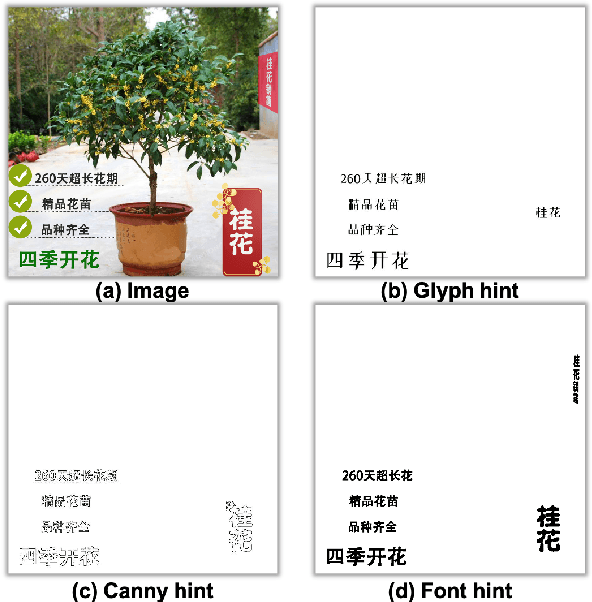



Abstract:Generating images with accurately represented text, especially in non-Latin languages, poses a significant challenge for diffusion models. Existing approaches, such as the integration of hint condition diagrams via auxiliary networks (e.g., ControlNet), have made strides towards addressing this issue. However, diffusion models often fall short in tasks requiring controlled text generation, such as specifying particular fonts or producing text in small fonts. In this paper, we introduce a novel approach for multilingual visual text creation, named JoyType, designed to maintain the font style of text during the image generation process. Our methodology begins with assembling a training dataset, JoyType-1M, comprising 1 million pairs of data. Each pair includes an image, its description, and glyph instructions corresponding to the font style within the image. We then developed a text control network, Font ControlNet, tasked with extracting font style information to steer the image generation. To further enhance our model's ability to maintain font style, notably in generating small-font text, we incorporated a multi-layer OCR-aware loss into the diffusion process. This enhancement allows JoyType to direct text rendering using low-level descriptors. Our evaluations, based on both visual and accuracy metrics, demonstrate that JoyType significantly outperforms existing state-of-the-art methods. Additionally, JoyType can function as a plugin, facilitating the creation of varied image styles in conjunction with other stable diffusion models on HuggingFace and CivitAI. Our project is open-sourced on https://jdh-algo.github.io/JoyType/.
Robot Manipulation in Salient Vision through Referring Image Segmentation and Geometric Constraints
Sep 17, 2024Abstract:In this paper, we perform robot manipulation activities in real-world environments with language contexts by integrating a compact referring image segmentation model into the robot's perception module. First, we propose CLIPU$^2$Net, a lightweight referring image segmentation model designed for fine-grain boundary and structure segmentation from language expressions. Then, we deploy the model in an eye-in-hand visual servoing system to enact robot control in the real world. The key to our system is the representation of salient visual information as geometric constraints, linking the robot's visual perception to actionable commands. Experimental results on 46 real-world robot manipulation tasks demonstrate that our method outperforms traditional visual servoing methods relying on labor-intensive feature annotations, excels in fine-grain referring image segmentation with a compact decoder size of 6.6 MB, and supports robot control across diverse contexts.
 Add to Chrome
Add to Chrome Add to Firefox
Add to Firefox Add to Edge
Add to Edge